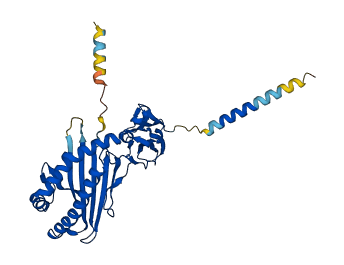Q4ACW4
Gene name |
CD1D |
Protein name |
Antigen-presenting glycoprotein CD1d |
Names |
|
Species |
Pan troglodytes (Chimpanzee) |
KEGG Pathway |
ptr:469524 |
EC number |
|
Protein Class |
|

Descriptions
The autoinhibited protein was predicted that may have potential autoinhibitory elements via cis-regPred.
Autoinhibitory domains (AIDs)
Target domain |
|
Relief mechanism |
|
Assay |
cis-regPred |
Accessory elements
No accessory elements
Autoinhibited structure

Activated structure

1 structures for Q4ACW4
| Entry ID | Method | Resolution | Chain | Position | Source |
|---|---|---|---|---|---|
| AF-Q4ACW4-F1 | Predicted | AlphaFoldDB |
No variants for Q4ACW4
| Variant ID(s) | Position | Change | Description | Diseaes Association | Provenance |
|---|---|---|---|---|---|
| No variants for Q4ACW4 | |||||
No associated diseases with Q4ACW4
Functions
8 GO annotations of cellular component
| Name | Definition |
|---|---|
| basolateral plasma membrane | The region of the plasma membrane that includes the basal end and sides of the cell. Often used in reference to animal polarized epithelial membranes, where the basal membrane is the part attached to the extracellular matrix, or in plant cells, where the basal membrane is defined with respect to the zygotic axis. |
| endoplasmic reticulum membrane | The lipid bilayer surrounding the endoplasmic reticulum. |
| endosome membrane | The lipid bilayer surrounding an endosome. |
| external side of plasma membrane | The leaflet of the plasma membrane that faces away from the cytoplasm and any proteins embedded or anchored in it or attached to its surface. |
| extracellular space | That part of a multicellular organism outside the cells proper, usually taken to be outside the plasma membranes, and occupied by fluid. |
| integral component of membrane | The component of a membrane consisting of the gene products and protein complexes having at least some part of their peptide sequence embedded in the hydrophobic region of the membrane. |
| lysosomal membrane | The lipid bilayer surrounding the lysosome and separating its contents from the cell cytoplasm. |
| lysosome | A small lytic vacuole that has cell cycle-independent morphology found in most animal cells and that contains a variety of hydrolases, most of which have their maximal activities in the pH range 5-6. The contained enzymes display latency if properly isolated. About 40 different lysosomal hydrolases are known and lysosomes have a great variety of morphologies and functions. |
4 GO annotations of molecular function
| Name | Definition |
|---|---|
| endogenous lipid antigen binding | Binding to an endogenous cellular lipid antigen. |
| exogenous lipid antigen binding | Binding to an exogenous lipid antigen (examples include microbial lipids and glycolipids). |
| lipid antigen binding | Binding to a lipid antigen. |
| lipopeptide binding | Binding to a lipopeptide, any of a group of organic compounds comprising two or more amino acids linked by peptide bonds and containing a nonprotein group consisting of a lipid or lipids. |
4 GO annotations of biological process
| Name | Definition |
|---|---|
| antigen processing and presentation, endogenous lipid antigen via MHC class Ib | The process in which an antigen-presenting cell expresses lipid antigen of endogenous origin in association with an MHC class Ib protein complex on its cell surface. Class Ib here refers to non-classical class I molecules, such as those of the CD1 family. |
| antigen processing and presentation, exogenous lipid antigen via MHC class Ib | The process in which an antigen-presenting cell expresses lipid antigen of exogenous origin in association with an MHC class Ib protein complex on its cell surface. Class Ib here refers to non-classical class I molecules, such as those of the CD1 family. |
| innate immune response | Innate immune responses are defense responses mediated by germline encoded components that directly recognize components of potential pathogens. |
| positive regulation of T cell mediated cytotoxicity | Any process that activates or increases the frequency, rate or extent of T cell mediated cytotoxicity. |
3 homologous proteins in AiPD
| 10 | 20 | 30 | 40 | 50 | 60 |
| MGCLLFLLLW | ALLQAWGSAE | VPQRLFPLRC | LQISSFANSS | WTRTDGLAWL | GELQTHSWSN |
| 70 | 80 | 90 | 100 | 110 | 120 |
| DSDTVRSLKP | WSQGTFSDQQ | WETLQHIFRV | YRSSFTRDVK | EFAKMLRLSY | PLELQVSAGC |
| 130 | 140 | 150 | 160 | 170 | 180 |
| EVHPGNASNN | FFHVAFQGKD | ILSFQGTSWE | PTQEAPLWVN | LAIQVLNQDK | WTRETVQWLL |
| 190 | 200 | 210 | 220 | 230 | 240 |
| NGTCPQFVSG | LLESGKSELE | KQVKPKAWLS | RGPSPGPGRL | LLVCHVSGFY | PKPVWVKWMR |
| 250 | 260 | 270 | 280 | 290 | 300 |
| GEQEQQDTQP | GDILPNADET | WYLRATLDVA | AGEAAGLSCR | VKHSSLEGQD | IILYWGGSYT |
| 310 | 320 | 330 | |||
| SVGLIVLAVL | ACLLFLLIVG | FTSRFKRQTS | YQGVL |